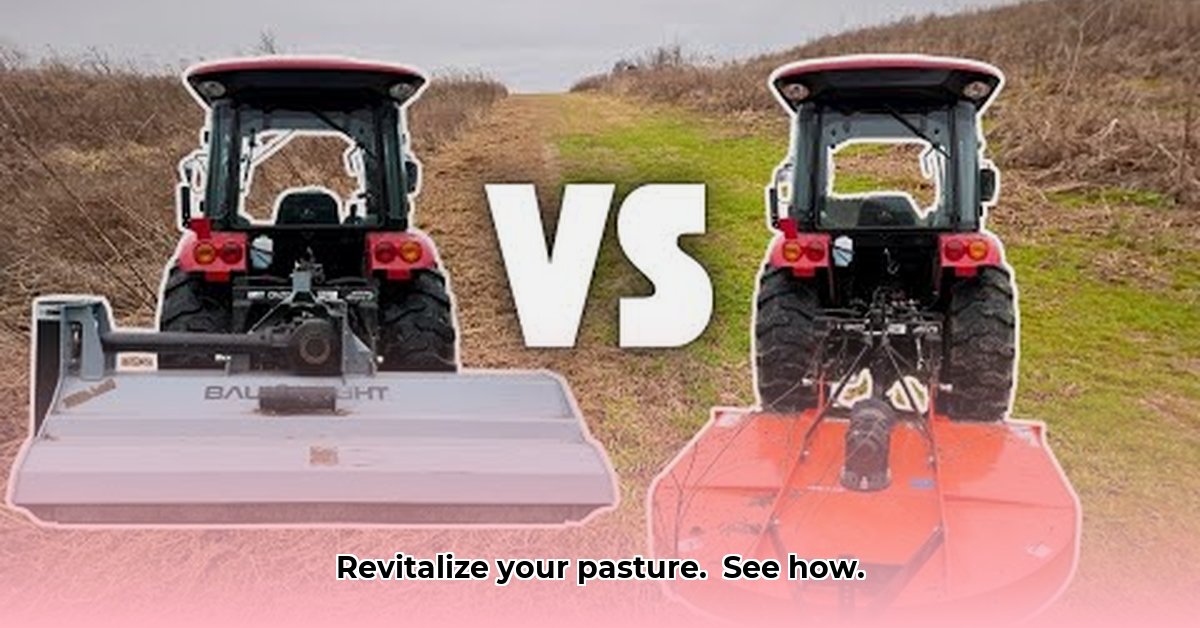
Flail Mowers: A Sustainable Solution for Pasture Management
Maintaining healthy, productive pastures is critical for sustainable agriculture. Traditional mowing methods often leave behind long clippings, robbing the soil of valuable nutrients and potentially harming the delicate ecosystem. Enter the PTO flail mower (power take-off flail mower), a powerful tool that offers a more sustainable approach. But what exactly makes them so effective, and how can you integrate them into your farming practices? For smaller-scale solutions, check out DIY mowing options.
This article explores the benefits and drawbacks of flail mowers, providing a practical guide to their use in sustainable grazing systems.
Flail Mower Tractor Supply: Revitalizing Your Pasture the Sustainable Way
Unlike traditional mowers that simply cut grass, flail mowers shred it, creating a fine mulch that acts as a natural fertilizer. This mulch enriches the soil, improving its health and fertility, a key element of sustainable agriculture. Do you want to improve soil health and nutrient cycling? Flail mowers can help you achieve that. They also often reduce the number of passes needed, saving you time and fuel – contributing to a smaller carbon footprint.
Flail Mowers: Weighing the Advantages and Disadvantages
The decision to invest in a flail mower involves careful consideration. Here's a balanced look at the pros and cons:
| Advantage | Disadvantage |
|---|---|
| Significantly reduces or eliminates herbicide use. | Higher initial purchase price than simpler mowers. |
| Creates nutrient-rich mulch, improving soil health and fertility. | Requires more regular maintenance (blade sharpening, etc.). |
| Encourages greater pasture biodiversity. | May consume more fuel than smaller mowers, especially on large pastures. |
| Produces higher-quality forage for livestock. | Can be noisy; consider noise ordinances and neighbors. |
| Effective weed control. | Requires proper disposal at end-of-life. |
| Less soil compaction than some heavier equipment. | Needs a sufficiently powerful tractor. |
Finding the Right Flail Mower: A Personalized Approach
Choosing a flail mower requires careful planning. First, accurately assess your tractor's horsepower. Underpowering the mower leads to poor performance and potential damage. Second, consider the size of your pasture; a wider cutting swath means fewer passes, but your tractor must have the power to handle it. Third, determine your budget; flail mowers vary significantly in price. Consult with your local agricultural equipment supplier – they can help you select the right mower for your needs and budget.
Integrating Flail Mowers into Your Sustainable Grazing Strategy: A Step-by-Step Guide
Successfully using a flail mower requires a strategic approach:
- Assess Your Pasture: Evaluate terrain, vegetation, and soil type to determine the optimal mowing height and techniques.
- Select the Right Mower: Consult with an equipment supplier to choose a mower compatible with your tractor and pasture conditions.
- Prepare the Area: Remove rocks and debris to prevent mower damage.
- Adjust Cutting Height: Experiment to find the best height for your pasture and vegetation.
- Prioritize Safety: Always follow manufacturer's safety guidelines.
- Monitor and Adapt: Observe pasture response and adjust mowing practices as needed. Sustainable agriculture is an iterative process.
- Maintain Regularly: Regular maintenance (blade sharpening, oil changes) extends mower lifespan and efficiency.
How to Reduce the Environmental Impact of Flail Mowers
While flail mowers offer significant benefits, their environmental impact deserves consideration. Responsible use minimizes negative consequences.
Minimizing Environmental Impact: Strategic Practices
- Strategic Mowing Patterns: Employ spiral mowing patterns to reduce edge disturbance and protect wildlife habitats.
- Careful Timing: Avoid mowing during sensitive wildlife breeding seasons.
- Proper Maintenance: Regular maintenance minimizes fuel consumption and mechanical failures.
- Blade Selection: Use sharp, appropriately sized blades for efficient cutting and reduced vegetation damage.
- Consider Alternatives: For smaller areas or specific tasks, explore alternatives such as rotary mowers or even manual methods.
Long-Term Sustainability: A Holistic View
True sustainable agriculture transcends individual tools. Consider the environmental impact of manufacturing and disposal. Choosing a durable, well-made mower that lasts longer reduces overall environmental impact. Responsible disposal practices are also vital at the end of the mower's life.
Conclusion: Making Flail Mowers Work for You
Flail mowers are a valuable investment for sustainable pasture management. By carefully considering the factors outlined here, you can integrate this tool into your farming practices effectively. Remember, your local equipment supplier and agricultural extension services are valuable resources for ongoing support and expertise.